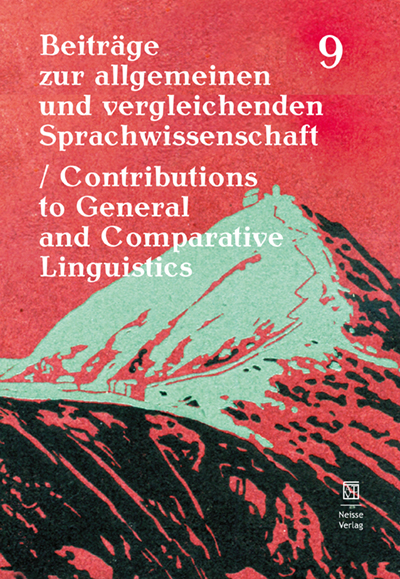
Beiträge zur allgemeinen und vergleichenden Sprachwissenschaft / Contributions to General and Comparative Linguistics
Heft 9 (2020): Varia et miscellanea
Herausgegeben von: Edyta Błachut, Adam Gołębiowski, Dorota Klimek-Jankowska, Krzysztof Migdalski
English animal zero plurals. A new explanation
DOI: 10.23817/bzspr.9-1 (online zugänglich: 2021-03-05)
S. 7–27
Schlüsselwörter: number, English animal zero plural
The paper explores English animal zero plurals using data culled from the BNC and argues that the rarely discussed pattern is motivated by a cognitive factor. Specifically, it is argued that the use of the zero plural mirrors the inability to individuate referents in their natural habitat, i.e. the inability to distinguish between particular individuals. In nouns designating aquatic creatures the inability is rooted in the fact that human eyesight is able to penetrate the water surface only to a very limited extent, which makes animals that live underwater and do not surface practically invisible (e.g. They caught lots of herring vs. They observed a pod of whales). In the case of land animals and birds the inability is due to the fact that some animals live in large groups, which thwarts distinguishing particular specimens (e.g. They watched a herd of wildebeest / a covey of quail vs. They spooked a couple of grizzly bears). It is further shown that the zero plural pattern is the most widespread in generic contexts (e.g. There are about 2,700 species of snake), which accords well with the explanation argued for in the paper as species are mental constructs that can be readily talked about but are invisible to the naked eye.
Zur Bildung von Personenbezeichnungen nach den Vorstellungen von einer gendergerechten Sprache. Kritische Bemerkungen zum deutschen und zum polnischen Sprachgebrauch / Different ways of referring to individuals in gender-sensitive language. Critical remarks on German and Polish language usage
DOI: 10.23817/bzspr.9-2 (online zugänglich: 2021-03-05)
S. 29–50
Schlüsselwörter: gender distinctions, gender marking suffix, gender-sensitive language, grammatical acceptability, referring to individuals, German, Polish
The change of social, political and professional gender roles has affected the way gender distinctions are expressed in language in different social groups including the scientific community. Gender distinctions can be either marked or they can be neutralized. The goal of this article is to present different ways of forming gender-sensitive expressions in Polish and German. Both German and Polish employ many linguistic devices to make gender distinctions, which can be either reflected in spelling and word-formation (e.g. using the gender marking asterisk * or gender marking suffixes) or in the linguistic system (e.g. new forms describing feminine job titles). The presented examples are discussed from various perspectives (form and content, grammatical acceptability, stylistic level, etc.).
Palatalization in Ukrainian, Polish and Russian. A pilot 3D Ultrasound Study
DOI: 10.23817/bzspr.9-3 (online zugänglich: 2021-03-05)
S. 51–71
Schlüsselwörter: palatalization, ultrasound speech research, Advanced Tongue Root
The paper reports findings of a pilot 3D/4D ultrasound study on the articulation of palatalized coronal obstruents in Ukrainian, Polish and Russian. The study quantitatively evaluates the degree of palatalization looking at the relative dorsum frontings/dorsum raising/ advancement of the tongue root as variables. Apart from the fronting and raising of the tongue dorsum, palatalized consonants show a systematic effect of the advancement of the tongue root. The preliminary results indicate that the effect of the position of the dorsum is bigger in phonemic palatalization than in allophonic palatalization, while the effect size of the tongue root remains similar across palatalization types.
Zum neutralen, verhüllenden und dysphemistischen Sprachgebrauch in deutschsprachigen Traueranzeigen / On the neutral, euphemistic and dysphemistic language use in German obituaries
DOI: 10.23817/bzspr.9-4 (online zugänglich: 2021-03-05)
S. 73–90
Schlüsselwörter: communication about death, dysphemistic language, euphemistic language, German obituaries
The communication about death is determined by numerous social constraints, resulting from the fear of the confrontation with this inevitable experience, as well as the sacralisation of the sphere of dying in the European culture. In this paper we analyse the influence of the social convention on the language use in German obituaries. The focus of the analysis lies on the typology of designations of death, as well as various forms of neutral, euphemistic and dysphemistic notification of decease.
Nominalisierung in Abstracts deutscher und polnischer sprachwissenschaftlicher Artikel / Nominalization in abstracts of German and Polish research articles in linguistics
DOI: 10.23817/bzspr.9-5 (online zugänglich: 2021-03-05)
S. 91–114
Schlüsselwörter: nominalization, academic texts, nominal style, syntactic compression, contrastive linguistics
The aim of this study is to analyze and compare the use of nominalized verbs and adjectives in abstracts of research articles in linguistics written by German- and Polish-speaking scientists. The paper begins by describing academic texts as a subject of (comparative) linguistic investigation. The next section focuses on structure and pragmatic features of abstracts as components of research articles. Subsequently the role of nominalization as one of the strategies of syntactic compression (also called syntactic condensation) and as an element of nominal style in academic texts is discussed. The next part presents the results of qualitative analysis of the data gained from 20 German and 20 Polish abstracts of research articles in linguistics. The concluding section 6 sums up the presented study and offers some recommendations for further research.
Die Entwicklung der linguistischen Terminologie zwischen Standardisierung und Variation am Beispiel des digitalen historischen Wörterbuchs der grammatischen Termini / The development of linguistic terminology between strandardization and variation: the example of the digital historical dictionary of grammatical terms
DOI: 10.23817/bzspr.9-6 (online zugänglich: 2021-03-05)
S. 115–131
Schlüsselwörter: Grammar Terminology, Grammar Writing, National Languages, Historical Dictionary
The aim of this paper is to present the online dictionary “Słownik historyczny terminów gramatycznych” that is currently being compiled by scholars from the University of Warsaw as well as to describe the research opportunities given by this dictionary. The source material for this dictionary consists of orthography books, grammar books and textbooks for learning Polish written in Polish and in other languages between the 1400s and the 1900s. Thanks to such a long time span considered not only can one observe a more than 500-year tradition of grammar writing but also the historical development of grammar terminology in the national languages. This paper describes this process on the example of the terms ortografia (orthography), etymologia (etymology), syntaxis (syntax), prozodia (prosody), frazeologia (phraseology).
Grammatikalisierung als Glied in der Kette der Sprachwandelprozesse anhand von ausgewählten Beispielen aus der ostdeutschen „Apostelgeschichte“ aus dem 14. Jahrhundert / Grammaticalization as a link in the chain of the language changes on the basis of the chosen examples from the Acts of the Apostles from 14th century
DOI: 10.23817/bzspr.9-7 (online zugänglich: 2021-03-05)
S. 133–152
Schlüsselwörter: Middle High German, grammaticalization, subject pronoun, article, Futur I
The article hereunder presents the language analysis of the “Acts of the Apostles” from 14th century published by Walther Ziesemer in 1927. The text of an unknown scribe was written in Early New High German in the Silesian dialect. The aim of the paper is to analyze the grammaticalization’s grade of chosen morphological and syntactic language features. In the investigation there is scrutinized the using of the mandatory subject pronouns and of the articles, which can be seen as a result of the weakening of vowel articulation and the subsequent development of the vowels in the unstressed syllables. The third part of the paper concerns the forming of the German future tense (Futur I) and its absolute presence in the analyzed text from the middle of the 14th century without other forms with the modal or motion verbs. The author introduces the results of his analysis showing the stage of the development of the chosen morphological and syntactic phenomena with the appropriate examples.
What motivates older adult learners in Poland to study foreign languages in later life?
DOI: 10.23817/bzspr.9-8 (online zugänglich: 2021-03-05)
S. 153–171
Schlüsselwörter: motivation, Foreign Language Geragogy (FLG), late-life foreign language learning and teaching, lifelong learning, older adults
Older adult cohorts (aged 60 and older) currently represent approximately 24% of the population of Poland. It is expected that by 2050 this proportion will increase to 40.4% of the overall population. The demographic change is also reflected in the continuing widespread popularity of various courses designed for this age group and the resulting rise of the number of Universities of the Third Age and other senior centres. However, in order to offer propitious and motivating learning environment for this age group, more research into the participants’ expectations and goals is needed. Three major findings were identified in this study: (a) older adults take up learning languages in later life in order to communicate while travelling (also with their families who live abroad); to socialise and get to know new people and cultures; to maintain intellectual abilities and to develop cognitively; (b) the instructor and other learners are key components in improving older adults’ motivation; and (c) stereotypes related to senescence and to Foreign Language Geragogy should be challenged to make classes relevant and interesting for this age group.
Numeral Subjects in Polish: Surface Morphology vs. Abstract Syntax
DOI: 10.23817/bzspr.9-9 (online zugänglich: 2021-03-05)
S. 173–204
Schlüsselwörter: the numeral subject, default agreement, subjecthood properties, case theory
Numeral subjects in Polish show a non-uniform agreement pattern with the verb depending on the cardinality of the numeral (paucal vs. high) and the gender of the NP. Full agreement shows with paucal numerals (<5) on non-virile NPs, while high numerals (≥5,) require default agreement (3 person, neuter, singular) on the verb. Paucal numerals combined with virile NPs may show either full agreement or default agreement, while high numerals with virile NPs show default agreement. Furthermore, high numerals combined with virile NPs show a surface morphological form of accusative/genitive, whereas high numerals combined with non-virile NPs show a surface morphological form of accusative/nominative. At the same time all the subtypes of the numeral subject share crucial syntactic properties with the standard nominative subject (e.g. coordination, anaphoric binding, control). This contribution reports on a plausible account of the morphological aspect of the overt (dis-)agreement between the numeral subject and the verb and proposes an account of an abstract syntactic relation between the numeral subject and Tense which resembles the standard procedure of nominative case marking.

